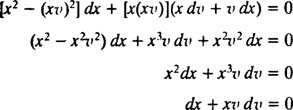First-Order Homogeneous Equations
A function f( x,y) is said to be homogeneous of degree n if the equation

holds for all x,y, and z (for which both sides are defined).
Example 1: The function f( x,y) = x 2 + y 2 is homogeneous of degree 2, since

Example 2: The function  is homogeneous of degree 4, since
is homogeneous of degree 4, since

Example 3: The function f( x,y) = 2 x + y is homogeneous of degree 1, since

Example 4: The function f( x,y) = x 3 – y 2 is not homogeneous, since

which does not equal z n f( x,y) for any n.
Example 5: The function f( x,y) = x 3 sin ( y/x) is homogeneous of degree 3, since

A first‐order differential equation  is said to be homogeneous if M( x,y) and N( x,y) are both homogeneous functions of the same degree.
is said to be homogeneous if M( x,y) and N( x,y) are both homogeneous functions of the same degree.
Example 6: The differential equation

is homogeneous because both M( x,y) = x 2 – y 2 and N( x,y) = xy are homogeneous functions of the same degree (namely, 2).
The method for solving homogeneous equations follows from this fact:
The substitution y = xu (and therefore dy = xdu + udx) transforms a homogeneous equation into a separable one.
Example 7: Solve the equation ( x 2 – y 2) dx + xy dy = 0.
This equation is homogeneous, as observed in Example 6. Thus to solve it, make the substitutions y = xu and dy = x dy + u dx:

This final equation is now separable (which was the intention). Proceeding with the solution,

Therefore, the solution of the separable equation involving x and v can be written

To give the solution of the original differential equation (which involved the variables x and y), simply note that

Replacing v by y/ x in the preceding solution gives the final result:

This is the general solution of the original differential equation.
Example 8: Solve the IVP

Since the functions

are both homogeneous of degree 1, the differential equation is homogeneous. The substitutions y = xv and dy = x dv + v dx transform the equation into

which simplifies as follows:

The equation is now separable. Separating the variables and integrating gives

The integral of the left‐hand side is evaluated after performing a partial fraction decomposition:

Therefore,

The right‐hand side of (†) immediately integrates to

Therefore, the solution to the separable differential equation (†) is

Now, replacing v by y/ x gives

as the general solution of the given differential equation. Applying the initial condition y(1) = 0 determines the value of the constant c:

Thus, the particular solution of the IVP is

which can be simplified to

as you can check.
Technical note: In the separation step (†), both sides were divided by ( v + 1)( v + 2), and v = –1 and v = –2 were lost as solutions. These need not be considered, however, because even though the equivalent functions y = – x and y = –2 x do indeed satisfy the given differential equation, they are inconsistent with the initial condition.